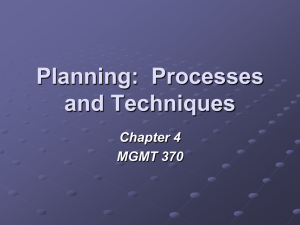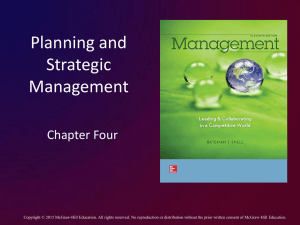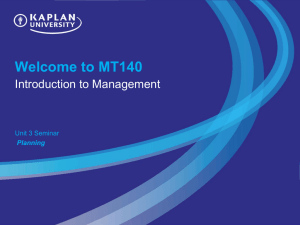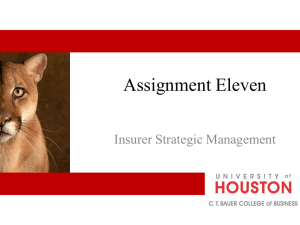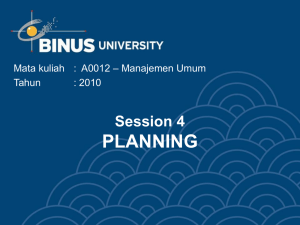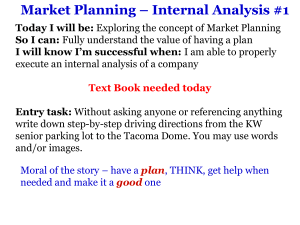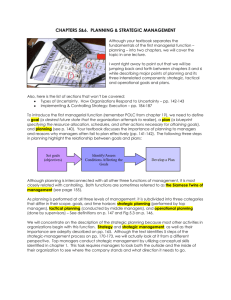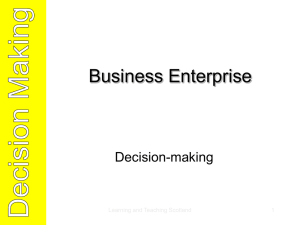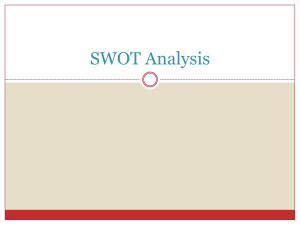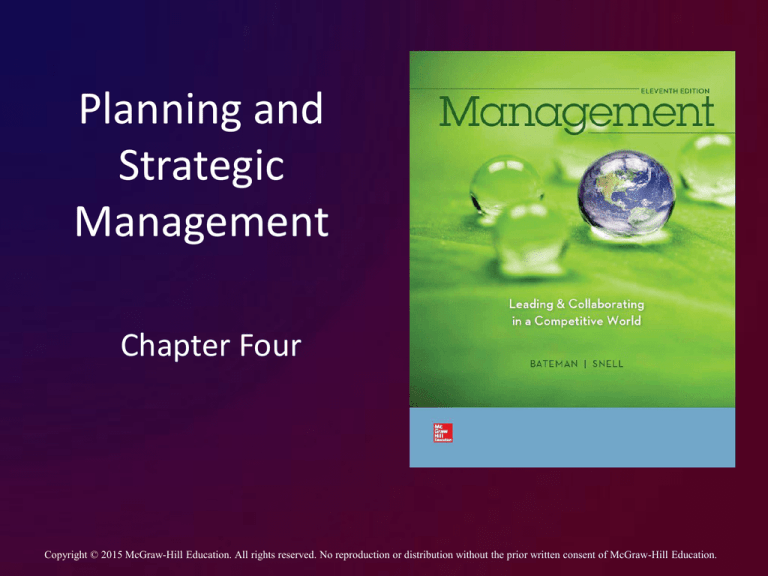
Planning and
Strategic
Management
Chapter Four
Copyright © 2015 McGraw-Hill Education. All rights reserved. No reproduction or distribution without the prior written consent of McGraw-Hill Education.
Learning Objectives
LO1 Summarize the basic steps in any planning
process.
LO2 Describe how strategic planning should be
integrated with tactical and operational
planning.
LO3 Identify elements of the external environment
and internal resources of the firm to analyze
before formulating a strategy.
LO4 Define core capabilities and explain why they
provide the foundation for business strategy.
4-2
Learning Objectives (cont.)
LO5 Summarize the types and choices available for
corporate strategy.
LO6 Discuss how companies can achieve competitive
advantage through business strategy.
LO7 Describe the keys to effective strategy
implementation.
4-3
Decision Making Stages and
Formal Planning Steps
Figure 4.1
4-4
Planning
Planning
conscious, systematic process of making
decisions about goals and activities that an
individual, group, work unit, or organization will
pursue in the future.
a purposeful effort that is directed and controlled
by managers and often draws on the knowledge
and experience of employees throughout the
organization.
4-5
The Basic Planning Process
Step 1 Situational Analysis
Step 2 Alternative Goals and Plans
Step 3 Goal and Plan Evaluation
Step 4 Goal and Plan Selection
Step 5 Implementation
Step 6 Monitor and Control
4-6
Situational Analysis
Situational analysis
A process planners use, within time and resource
constraints, to gather, interpret, and summarize
all information relevant to the planning issue
under consideration.
4-7
Alternative Goals and Plans
Should stress creativity and encourage
managers and employees to think in broad
terms about their jobs.
Goal
A target or end that management desires to
reach
Specific, measurable, attainable, relevant, timebound - SMART
4-8
Question
___________ are the actions or means
managers intend to use to achieve
organizational goals.
A. Missions
B. Plans
C. Strategies
D. Services
4-9
Alternative Goals and Plans
Plans
The actions or means
managers intend to
use to achieve
organizational goals
Contingency plans
sets of actions to be
taken when a
company’s initial
plans have not
worked well or if
events in the
external
environment require
a sudden change
4-10
Goal and Plan Evaluation
Managers will evaluate the advantages,
disadvantages, and potential effects of each
alternative goal and plan.
Must prioritize those goals and even eliminate
some of them.
Managers must consider carefully the
implications of alternative plans for meeting high
priority goals.
4-11
Goal and Plan Selection
Managers will select the option that is most
appropriate and feasible
The evaluation process will identify the
priorities and trade-offs among the goals and
plans
Scenario
A narrative that describes a particular set of
future conditions.
4-12
Implementation
Managers and employees must understand
the plan, have the resources to implement it,
and be motivated to do so
Successful implementation requires a plan to
be linked to other systems in the
organization, particularly the budget and
reward systems
4-13
Monitor and Control
Managers must continually monitor the actual
performance of their work units against the
unit’s goals and plans.
Manager’s also need to develop control systems
to measure that performance and allow them to
take corrective action when the plans are
implemented improperly or when the situation
changes
4-14
Strategic Planning
Strategic planning
A set of procedures
for making decisions
about the
organization’s longterm goals and
strategies
Strategic goals
major targets or end
results that relate to
the long-term
survival, value, and
growth of the
organization.
4-15
Strategic Planning
Strategy
A pattern of actions
and resource
allocations designed
to achieve the
organization’s goals
4-16
Strategic Planning
1. Where will we be active?
2. How will we get there?
3. How will we win in the marketplace?
4. How fast will we move and in what
sequence will we make changes?
5. How will we obtain financial returns?
4-17
Hierarchy of Goals and Plans
Figure 4.2
4-18
Tactical and Operational Planning
Tactical planning
A set of procedures for translating broad
strategic goals and plans into specific goals and
plans that are relevant to a distinct portion of the
organization, such as a functional area like
marketing.
4-19
Tactical and Operational Planning
Operational planning
The process of identifying the specific
procedures and processes required at lower
levels of the organization.
4-20
The Strategy Map
Figure 4.3
4-21
Strategic Planning
Strategic management
A process that involves managers from all parts
of the organization in the formulation and
implementation of strategic goals and strategies.
4-22
The Strategic Management Process
Figure 4.4
4-23
Question
An organization’s __________ is the basic
purpose and scope of operations.
A. Mission
B. Strategy
C. Goal
D. Policy
4-24
Establishment of Mission, Vision,
and Goals
Mission
An organization’s
basic purpose and
scope of operations.
4-25
Establishment of Mission,
Vision, and Goals
Strategic vision
the long-term direction and strategic intent of a
company
provides a perspective on where the organization
is headed and what it can become
4-26
Analysis of External Opportunities
and Threats
Stakeholders
Groups and
individuals who
affect and are
affected by the
achievement of the
organization’s
mission, goals, and
strategies
4-27
Analysis of Internal Strengths
and Weaknesses
Resources
Inputs to a system that can enhance
performance
Tangible, intangible assets
4-28
Internal Resource Analysis
Table 4.2
4-29
Resources and Core Competencies
Figure 4.5
4-30
Analysis of Internal Strengths and
Weaknesses
Benchmarking
process of assessing how well one company’s
basic functions and skills compare with those of
another company or set of companies.
goal of benchmarking is to thoroughly
understand the “best practices” of other firms
and to undertake actions to achieve both better
performance and lower costs
4-31
SWOT Analysis and Strategy
Formulation
SWOT analysis
A comparison of strengths, weaknesses,
opportunities, and threats that helps executives
formulate strategy.
4-32
SWOT Analysis and Strategy
Formulation
Corporate strategy
The set of businesses, markets, or industries in
which an organization competes and the
distribution of resources among those entities
Concentration
A strategy employed for an organization that
operates a single business and competes in a
single industry.
4-33
SWOT Analysis and Strategy
Formulation
Vertical integration
The acquisition or development of new
businesses that produce parts or components of
the organization’s product
Concentric diversification
A strategy used to add new businesses that
produce related products or are involved in
related markets and activities.
4-34
Summary of Corporate Strategies
Figure 4.7
4-35
BCG Matrix
Figure 4.8
4-36
SWOT Analysis and
Strategy Formulation
Low-cost strategy
A strategy an
organization uses to
build competitive
advantage by being
efficient and offering
a standard, no-frills
product
Differentiation
strategy
A strategy an
organization uses to
build competitive
advantage by being
unique in its industry
or market segment
along one or more
dimensions.
4-37
Strategy Implementation
1. Define strategic risks
2. Assess organization capabilities
3. Develop an implementation agenda
4. Create an implementation plan
4-38
Strategic Control
Strategic control system
A system designed to support managers in
evaluating the organization’s progress regarding
its strategy and, when discrepancies exist, taking
corrective action.
4-39
Video: Ball Corporation
What tactical planning steps did Ball
Corporation take to innovate and remain
competitive in the packaging industry?
Where do canning jars fit into the BCG
matrix?
4-40

